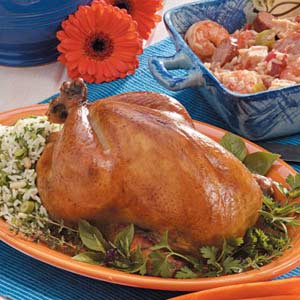|
Poultry and Your Diabetes Diet
Selecting your poultry wisely is an important part of your diabetes meal plan. Everyone loves to eat chicken. You can buy chicken whole or else turkey, and cut it up for cooking, or else roast the whole thing. You can buy parts that are ready to serve as well as ground up turkey or chicken. Many poultry items are sold fresh, frozen, or raw. And in the deli section of your grocery store, chicken and turkey is already precooked ahead of time and all you have to do is heat it up before serving. Chicken and turkey is, as a a whole, a healthy menu choice. But you must also know that some parts will be much higher in fat content than others. Also, the way you prepare these meats has a bearing on how much fat content you will end up with. These meats both have a high protein count. The fat count will depend upon which part it is you are choosing though. Of course taking off the skin on any part, subtracts from the fat count in the meat. Since the skin is really what helps turkey and chicken hold the moisture, it is best to peel off the skin right before you eat it. The typical allowance for a serving of turkey or chicken daily is around 3-4 ounces per serving. Keep in mind also, that if the poultry weighs 5 ounces raw, it will shrink down to 4 ounces after you cook it. Breaded and baked chicken, is often referred to as chicken tenders. This is meat that comes from the underside of the chicken. They are actually strips of rib meat. These chicken strips are often found in your grocer's deli section. Parts of the poultry of either chicken or turkey which is the legs or thighs are more flavorful then other parts. They hold greater moisture since the fat content is higher in these parts then in others. When you are buying either chicken or turkey, you will see different terms on their labeling. It may say something like natural, free range, organic, or farm raised. There may also be a produced without hormones or antibiotics label. It is the USDA that controls these labels. When the term farm raised is used, this is applicable to food sold in grocery stores. The term free range may be used if the animals were outdoors. Also anything which states organic on labels must meet the strict standards of the USDA. The USDA does not allow the use of antibiotics and requires other alternatives like organic feed. Any chicken or turkey that has a label of fresh on it must have been raw and had the correct temperature below 26 degrees. Anything less than the 26 degrees farenheit must be marked as frozen meat. Some chicken and turkey contain a solution which has been either injected or marinated. The meat weight with the solution inside is part of that total weight. For purposes of saving money, buying a fresh chicken or else a whole one is the best decision. Your store-bought and prepared chicken is a good choice if you don't want to cook one yourself. And with chicken purchased from the deli, you'll get that roasted taste if that's what you want. There are some chicken and turkey products sold in the grocery store that have no added ingredients to them. For the most part though, frozen or else fresh have a chicken broth and salt added for moisture purposes as well as good taste. The stuff added though will have more sodium in it. Read the label to find out the sodium count. If you have kidney trouble as well as diabetes, your sodium is something to watch out for. Everyone enjoys eating chicken wings, I know I do. Wings are high in fat when you buy them in the grocery store. The best thing to do is grill them yourself, or cook in the microwave. The grocery store has wings where you can prepare them with this cooking method. Chicken that is inside of a can is another quick way to eat low fat, and prepare for supper. Your canned chicken may have both dark and white meat along with the skin. When handling poultry, always do that part of your shopping last so that you can avoid warming temperatures. Always put the chicken or turkey in the fridge immediately after getting home. Keep it nice and cold, (even freeze it), until ready to cook. Wash your hands thoroughly and after you have prepared meats. Wash off your countertop with a clean sponge to avoid spreading of germs. You should always cook your poultry thoroughly as this is what destroys bacteria that might be left. Never eat anything raw.
|





